STL253: Woodworking is just tricks and fixing mistakes
Furniture maker and machinery guru Ellen Kaspern joins Anissa and Ben to answer listener questions about jointers and walnut slabs, and to proclaim her never-ending love of the Delta Unisaw.This episode is sponsored by Titebond, The Northwest Woodworking Studio, and Pony/Jorgensen
Question 1:
From Bill:
It is with a heavy heart that I have had to come to terms that I am going to have to place my workshop into an extended storage. My wife and I are returning to Massachusetts from Pennsylvania in the coming month. When all is done we will have our dream house and I will have my dream shop. Unfortunately we are building a home and it will be 15 months until we get to move in. As such I am having to place all of my workshop – hand tools and large woodworking machines in storage. I would like your guidance on how to properly prep and store my tools. Additionally I will be storing approximately 1000 ft do lumber and would like your guidance there also. Over the quiet period I plan on reading about, listening to and dreaming of the better woodworking days ahead. But it’s going to be difficult!
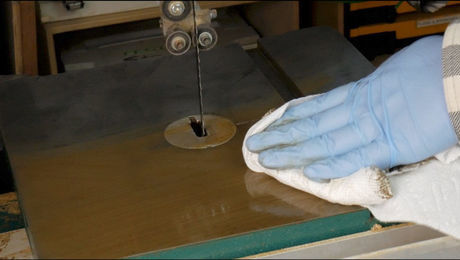 |
|
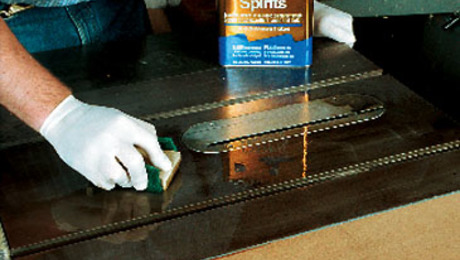 |
|
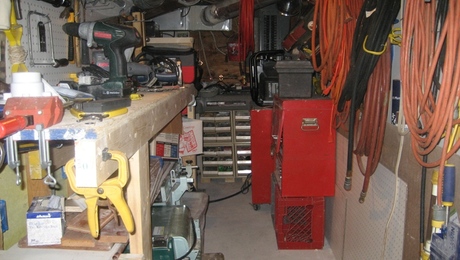 |
Question 2:
From Spenser:
I have a question regarding jointers. I see that most jointer planes are 22 inches long, and are the foremost at flattening boards by hand. However, when it comes to power tool jointers, everything I have ever read, seen, or heard states the longer the beds of the jointer, the better it is for flattening operations. What is the reasoning behind this? Is it merely that the power tool jointer needs the extra length to support the workpiece, whereas with a handplane the workpiece is clamped in place? If this is the case, then could I still get good results from placing a roller stand at the outfeed side of my rather short 6 inch Craftsman jointer (vintage, belt driven with cast iron beds and fence)? If not, what is the approximate length of stock one can safely and accurately flatten on a jointer of a given size (i.e., twice the length of the outfeed, etc.)?
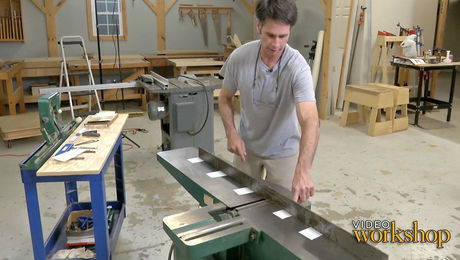 |
Machine Setup – The Jointer |
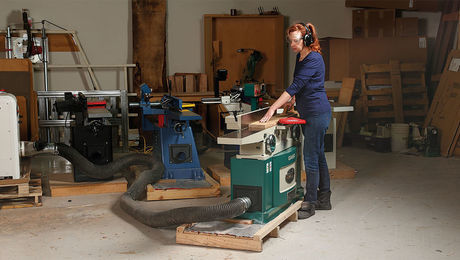 |
Segments
Ellen: All time favorite tool – The Unisaw
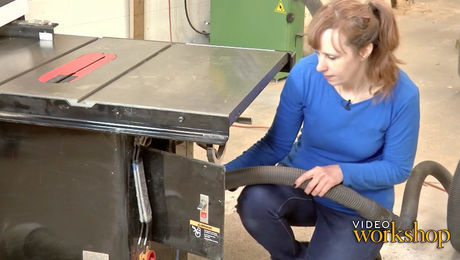 |
Machine Setup – The Tablesaw |
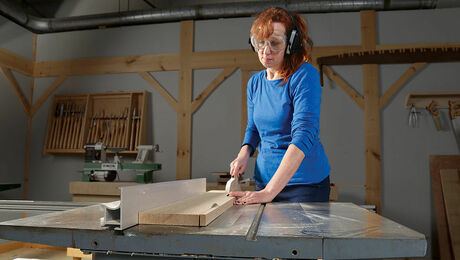 |
Tune Your Tablesaw |
Anissa: All-time favorite technique – Bob Van Dyke’s use of wedges to disassemble a dovetailed box (video at 47:45)
Ben: using a pair of dividers and a level to perfectly place screws for mounting things with keyhole slots
Question 3:
From John:
Not too long ago, I milled up a walnut tree on my parents’ property. All of the lumber will be used for dimensional boards except this live edge piece I had left over. I am still not sure what I want to do with, I am between a hall table, coffee table or small bench utilizing the live edge look of the piece. The problem I am running into is what species of wood should I use for the legs and other features of the piece that would go well with the combination of sap and heart wood present. I live in the Midwest and would prefer to use a native species if possible. What would you suggest or does this look like a good piece of firewood?
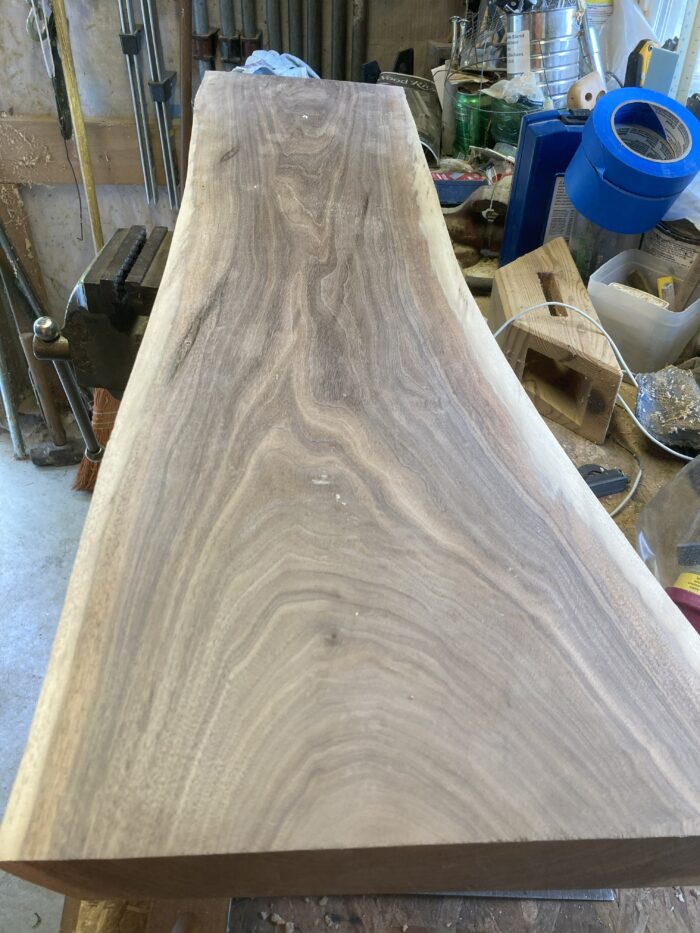
Anissa mentions Tim Coleman’s “Three Stories” cabinet.
Every two weeks, a team of Fine Woodworking staffers answers questions from readers on Shop Talk Live, Fine Woodworking‘s biweekly podcast. Send your woodworking questions to [email protected] for consideration in the regular broadcast! Our continued existence relies upon listener support. So if you enjoy the show, be sure to leave us a five-star rating and maybe even a nice comment on our iTunes page.






















Comments
Yes, off the ground, seal steel tools with a good automotive paint sealer. I use Menzerna paint sealant, to prevent rust, it will not affect use or steel and can be removed with acetone if needed. One bottle is a lifetime supply.
Plastic boxes, buy all the same boxes the same size/brand for stacking. I like, the HDX fold top clear boxes 21x15 x12. Tape a sheet cardstock label on both sides, or for clear boxes place a sheet of labeled cardstock on each end. Non tools can be packed and stored in cardboard boxes, again the same size for stacking.
Do not buy large 3foot boxes, you will have to lift them.
Smaller clear plastic shoe boxes with a masking tape labels on the top and also a 3X5 card on the inside end of the box. If you use the fold top boxes, 4- $1plastic shoeboxes fit perfectly in the fold-top box.
An open plastic 2 -3oz sample cup with kitty litter is extra insurance, an if spilled, no issue. Your stuff will likely stay in “storage” longer than you think.
A wood that may work with walnut is butternut. The grain very similar.
the thing ellen was trying to remember for moving heavy machinery is called a Johnson bar. it is usually a two inch thick piece of oak about 7 feet long with heavy duty steel wheels at the base and a 1/2 inch 90 degree steel plate tapered to a thin edge and bolted to the front side directly in front of the wheels. and yes it is great for moving heavy stuff. The leverage is incredile! I worked in a machine shop for 15 years and we used it for all kinds of machinery.
Ben, possible article subject...I'm curious to see what you have in the chests that were in the upper right of your frame, and how you have things laid out. Inquiring minds want to know
Ah! Those are actually a commission waiting to be shipped off. So they're empty!
The bar she is talking about is called a Johnson bar, it is a heavy duty pry bar, around 6-7’ long.
My shop is an unheated barn. I live outside of Philadelphia, Pennsylvania, so my tools are exposed to the ravages of the changes in temperatures brought about by all 4 seasons. Sometimes I feel like I spend more time addressing rust, than the corrosion control officer on an aircraft carrier does. As far as long-term storage of tools in an unheated area I would recommend the following:
With respect to machines that have a cast iron surface, i.e. table saw, band saw and planner, I have had good results by purchasing rolls of flexible magnetic material, that are sold for truck signs, and cutting them to size. I cut a piece of plywood that is ½ inch to an larger than the table and attach the magnetic material to the plywood. I have seen magnetic material sold precut to fit various machines, but it is much cheaper to buy it by the roll and make them yourself. As I put these covers on my machines when they are not in use, I find that they hold up much better if they are attached to plywood. The magnetic sheets are somewhat soft and the plywood protects them from the things that I inevitably tend to place on any unused horizontal surface. (It is important to make these slightly over sized, so that you can get a grip on them to pull them off. The first time I did this, I made them exactly the same size as the table and it was quite difficult to remove them.)
The investment that you have in sawblades and router bits may exceed the cost of a single big machine. I would suggest sending out every sawblade that needs to be sharpened to be sharpened to a sharpener that will coat the teeth of the blade with plastic when they are returned. You may want to consider seeing if the sharpener will dip all of your router bits with plastic as well.
Don't take tables off a jointer; you will have to adjust them later.
take the motor off a bandsaw.
Log in or create an account to post a comment.
Sign up Log in